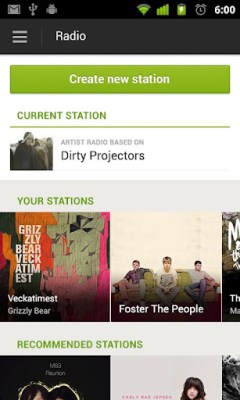When Spotify launched its new (and free) mobile radio functionality for iOS back in June, the company hinted that its Android counterparts would get it shortly but didn’t offer up any more detail than that. Well fandroids, that wait is over — Spotify just announced on its official blog that a newly-released update has finally brought that wallet-friendly feature to the service’s Android app.
The streaming radio feature — which lets users create stations based on a selected song, artist, or album — first made its debut in the desktop client back in December. It’s all very Pandora-esque, save for a few nifty enhancements. When users stumble upon a song they like for instance, they have the option of saving the track to a separate “Liked From Radio” playlist instead of scrambling to write down its name before it’s too late. What’s more, users can create an unlimited number of stations, as well as give tracks the ol’ thumbs up to influence future music choices.
Perhaps more important is the fact that its iOS launch was the first time non-paying users could access Spotify’s music catalog for any considerable amount of time; those users were previously stuck with a 48-hour free trial. Sure, those users have to put up with ads from the likes of Verizon Wireless, McDonald’s, Taco Bell, Red Bull, and more, but that’s arguably a small price to pay in exchange for access to Spotify’s sizable catalog.
As for why the long-awaited feature is only now making its way to Android, product manager Donovan Sung noted that it was an issue of balancing priorities. According to him, one of the reasons Radio for Android spent an extra month in the oven was because the team was “focused on making the Android app a lot better” first.
Just a week before the mobile radio feature made its debut on iOS, the company had pushed out a major update to its Android app that finally brought many of service’s most notable features to Google’s mobile platform — think social functionality, 320kbps audio streaming, playlist folders, and the like. With that update, the app finally shed its beta trappings, so it’s clear that implementing the mobile radio feature was a secondary priority at the time.
